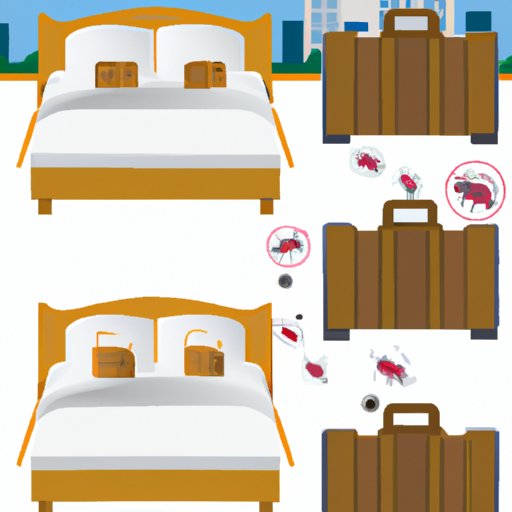Introduction
Bed bugs are small, parasitic insects that feed on human blood for nourishment. These pests can be found in a variety of places, including hotels, homes, and even public transportation. Unfortunately, bed bugs are quite adept at hitching rides on unsuspecting travelers, which can lead to infestations in new locations.

How to Protect Yourself from Bed Bug Infestations While Traveling
The best way to protect yourself from bed bug infestations while traveling is to inspect your hotel room before checking in. Make sure to check the mattress, box spring, headboard, and any upholstered furniture for signs of bed bug activity. If you spot any evidence of bed bugs, request a different room or ask to switch hotels altogether. Additionally, it’s important to minimize contact with bed bugs while traveling by avoiding secondhand furniture and beds, as well as keeping your luggage away from the bed and off the floor.
The Dangers of Bed Bugs in Hotels: What You Need to Know
Bed bug infestations in hotels can pose serious health risks to travelers. According to the Centers for Disease Control and Prevention (CDC), bed bug bites can cause skin rashes, allergic reactions, and in rare cases, infections. Common signs of bed bug infestation include dark spots on mattresses and sheets, live bugs, and an unpleasant musty odor.

How to Spot Signs of Bed Bug Infestation in Your Hotel Room
When inspecting your hotel room for signs of bed bug infestation, look for telltale signs such as tiny black spots on mattresses and sheets, live bed bugs, and a musty smell. Pay special attention to the seams, corners, and crevices of the mattress, as well as any upholstered furniture. It’s also important to check behind pictures, under carpets, and around outlets and light switches, as these are common hiding spots for bed bugs.
Tips for Keeping Bed Bugs Out When You’re On the Go
When traveling, there are several steps you can take to prevent bed bugs from entering your luggage and other belongings. First, make sure to store your suitcase on a hard, elevated surface rather than on the floor or bed. Additionally, keep your clothes and other items sealed in plastic bags and inspect them regularly for signs of bed bug activity. Finally, when returning home, immediately unpack your luggage outside to reduce the risk of introducing bed bugs into your home.

How to Identify Bed Bugs and Prevent Them From Spreading
It’s important to be able to identify bed bugs so you can take the necessary steps to prevent them from spreading. Adult bed bugs are reddish-brown in color and can grow up to 4 to 5 millimeters in length. Additionally, they have flattened bodies and long antennae. To prevent the spread of bed bugs, make sure to vacuum regularly, seal cracks and crevices, and wash all linens and clothing in hot water.
Understanding the Life Cycle of Bed Bugs: What You Need to Know
In order to effectively control bed bug infestations, it’s important to understand their life cycle. Adult bed bugs lay eggs which hatch into nymphs after about 10 days. Nymphs go through five instars before reaching adulthood, during which time they will feed on human blood. Fully grown bed bugs can survive without feeding for up to six months, making them difficult to eradicate.
Conclusion
Bed bugs are incredibly resilient pests that are capable of hitching rides on unsuspecting travelers. To protect yourself from bed bug infestations while traveling, it’s important to inspect your hotel room for signs of bed bug activity, minimize contact with bed bugs, and keep your luggage away from the bed and floor. Additionally, understanding the life cycle of bed bugs can help you properly identify them and take steps to prevent them from spreading.
(Note: Is this article not meeting your expectations? Do you have knowledge or insights to share? Unlock new opportunities and expand your reach by joining our authors team. Click Registration to join us and share your expertise with our readers.)
